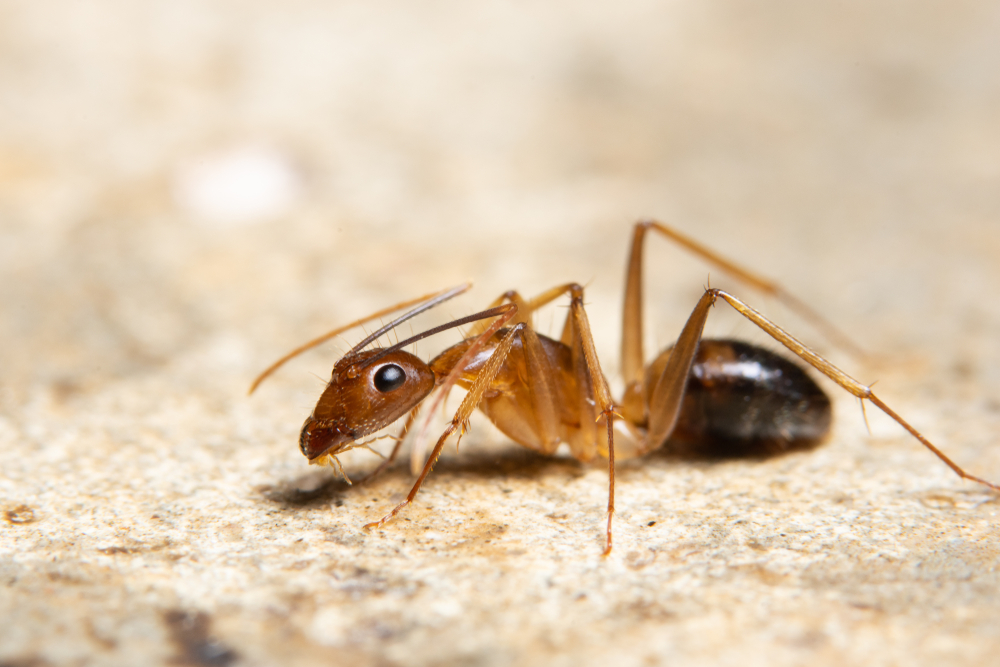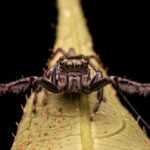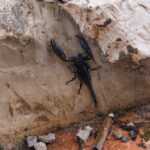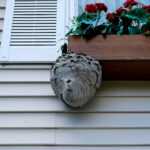Ghost Ants: Identification, Control, and Prevention Strategies
Dealing with ghost ants? Learn to identify them, control their spread, and prevent future infestations with this guide.
- Ghost ants, or Tapinoma melanocephalum, are small, translucent ants that thrive in warm, moist environments and often invade homes seeking sugary and protein-rich foods.
- Early identification of ghost ant infestations is crucial; signs include visible trails, nesting in moist areas, and their tendency to enter homes through small gaps.
- Effective control methods include DIY solutions like homemade baits and natural repellents, but professional pest control may be needed for severe infestations.
What Are Ghost Ants?
Ghost ants, scientifically known as Tapinoma melanocephalum, are tiny invaders that can be quite a nuisance in homes. These ants are among the smallest ant species, with worker ants measuring between 1.3 and 1.5 mm in length. Ghost ants are extremely small and difficult to spot. Their name, ghost ants, stems from their almost invisible appearance due to their pale, translucent legs and abdomens, which contrast with their dark head. The head and thorax are dark brown, sharply contrasting with the pale legs and abdomen. Their translucent legs and abdomens make them appear to vanish on light surfaces.
Despite their small size, a ghost ant worker can cause significant problems. Ghost ant workers are monomorphic, meaning they are all similar in size and shape, and are characterized by their extremely small size, 12-segmented antennae, a deep dark brown head and thorax, and a translucent or milky white gaster. They do not have stingers, making them less harmful compared to other pests, but their presence can be quite bothersome. The difficulty in spotting these ants in their natural habitat makes them a particularly tricky pest to deal with.
Recognizing the characteristics and size of ghost ants helps in managing infestations. Spotting these tiny ants early allows for prompt action to control their spread. As a tropical species, ghost ants thrive in warm, humid environments. Unlike other ant species, ghost ants are distinguished by their extremely small size and the stark contrast between their dark head and thorax and their pale legs and abdomen.
Identifying Ghost Ant Infestations
Identifying a ghost ant infestation can be challenging due to their small size and translucent bodies. However, there are telltale signs that can help you spot these pests. Ghost ants often leave visible ant trails on surfaces such as windowsills and countertops, especially in areas where they are actively foraging for food. These ant trails are key indicators of an infestation and can help you locate entry points and plan bait placement. Kitchens and bathrooms are common hotspots for ghost ant activity.
Ghost ants typically nest in moist environments, both indoors and outdoors. Indoors, their indoor colonies are often found nesting in wall voids, spaces under sinks, and behind baseboards. Outdoors, they prefer to nest in soil, under rocks, and in potted plants and ant nests. These ants can enter homes through tiny gaps and cracks, making it essential to inspect potential entry points regularly.
Early identification of ghost ant infestations is crucial for effective pest control. Identifying ghost ants and recognizing signs like visible ant trails and nesting sites allows for timely action to manage and eliminate these pests before they become a bigger issue.
Ghost Ant Behavior and Habitat
Ghost ants thrive in warm, humid environments, making both indoor and outdoor settings suitable for their nesting. Understanding their behavior and preferred habitats is key to effective ghost ant control. Indoors, ghost ants typically nest in wall voids, spaces between cabinetry and baseboards, and in flowerpots. These small ants often establish colonies in places where moisture is present, as it is crucial for their survival. Ghost ants are also known to establish colonies in residential buildings such as an apartment block.
Outdoors, ghost ants may nest in leaf litter, plant stems, under rocks, and in soil. They can enter homes by traveling along tree limbs that touch the house, as well as utility lines and shrubs.
Ghost ant colonies are unique in that they often contain multiple queens. This allows them to split into several sub-colonies, which can thrive in various environments. New colonies are established through a process called budding, where reproductive females and worker ants move to new nesting sites. Ghost ants can quickly establish new nests in favorable environments, making it challenging to completely eradicate ghost ant infestations without a thorough understanding of their nesting habits.
Understanding the behavior and habitat preferences of ghost ants aids in controlling their populations. Targeting their nesting sites and colony structures allows for more effective management strategies.
Why Do Ghost Ants Invade Homes?
Ghost ants are particularly drawn to homes due to their dietary preferences and the favorable conditions found indoors. Food residues and moisture attract ants, making kitchens and bathrooms common hotspots. They are especially attracted to spilled soda or sweet foods. These ants actively seek out sugary substances and protein sources to maintain their colony’s diet. Their preference for sweet foods has earned them the nickname “sugar ants”.
In addition to sweet substances, ghost ants also consume proteins, fruits, and fats. They are commonly found in homes, often near sources of household foods like syrups and sweet residues. Outdoors, the primary food source for ghost ants is honeydew, which is produced by aphids and other insects that produce honeydew. This sugary substance attracts ghost ants, as aphids and similar insects produce honeydew that serves as a major food source. The proximity to food sources, particularly household foods and honeydew, influences the habitat choices of ghost ants.
Moisture is another significant factor that attracts ghost ants to homes. They prefer environments with excess moisture, such as kitchens and bathrooms, where they can easily find the conditions they need to thrive. To prevent infestations, it is important to properly store food in airtight containers and eliminate moisture sources. Knowing why ghost ants invade homes enables you to take preventive measures to reduce their likelihood of entry.
DIY Methods to Get Rid of Ghost Ants
Before starting any DIY treatments, it is essential to conduct a thorough inspection to locate ghost ant nests, entry points, and ant pathways. Identifying ant pathways in your landscaping and around the home, especially where vegetation touches the house or garden sources like aphids are present, is crucial for effective control.
Managing ghost ant infestations can often be handled with DIY methods, which are both cost-effective and practical. Homemade baits, natural repellents, and cleanliness are effective strategies to control ghost ant populations.
These methods can manage ghost ant problems before they escalate, keeping your home ant-free.
Homemade Bait Recipes
Homemade baits can be a powerful tool in managing ghost ant infestations using common household ingredients. A sweet bait recipe consists of 1 part borax and 3 parts powdered sugar, dissolved in water. The sweet bait attracts ants, who then carry the toxic mixture back to their colony, effectively eliminating it from within.
For those who prefer a protein-based bait, combining 1 part borax with 3 parts peanut butter can be equally effective. Additionally, a non-toxic option involves mixing baking soda with sugar, which can also help manage ghost ant infestations.
These homemade bait recipes offer simple and effective solutions using readily available kitchen ingredients.
Natural Repellents
Natural repellents offer an eco-friendly way to deter ghost ants from your home. Peppermint oil, in particular, is an effective natural repellent against ghost ants. Applying peppermint oil around entry points and areas where ghost ants typically nest can help keep these pests at bay. This method ensures a safe environment for homes with pets and children.
Natural repellents not only control ghost ants but also promote a healthier living environment. These eco-friendly options are effective and safe, making them a practical solution for maintaining an ant-free home.
Maintaining Cleanliness
Maintaining cleanliness is key to preventing and managing ghost ant infestations. Keeping surfaces free of food debris, regular cleaning, and prompt removal of spills deter ghost ants.
Quickly addressing moisture issues is important, as ghost ants are drawn to moist areas. Removing organic debris near your home’s foundation can also reduce the likelihood of infestations.
Maintaining cleanliness and reducing moisture create an environment less conducive to ghost ant activity.
When to Call a Professional
If DIY methods fail to control ghost ant infestations, it may be time to call in professional pest control services. Professional help is often needed for complex infestations involving multiple pests. Professionals can manage ghost ant populations by following trails, treating nests, and using bait.
Knowing when to call a professional saves time and effort in dealing with severe infestations. Professionals have the tools and knowledge for comprehensive and long-term pest control solutions.
Preventing Future Infestations
Preventing future ghost ant infestations requires proactive measures and regular maintenance. Sealing openings with caulk or weatherstripping and eliminating food and water sources by storing sweet foods in airtight containers and cleaning up spills can deter ghost ants.
Regularly cleaning surfaces and reducing moisture sources are essential steps in maintaining cleanliness and preventing infestations. Additionally, sealing cracks, replacing ripped screens, trimming foliage around the house, and conducting regular inspections can further reduce the likelihood of ghost ant infestations.
Ghost ants are especially problematic in regions such as central Florida, central and southern Florida, southern Florida, and south Florida, and have also spread to the Caribbean islands and northern states, where they often survive indoors.
By taking these preventive measures, you can create an environment that is less attractive to ghost ants and other pests, ensuring your home remains pest-free.
Understanding ghost ants and their behavior is crucial for effective control and prevention. Identifying the signs of infestation, applying DIY methods, and knowing how to handle other pests such as roof rats, and knowing when to call in professional help are all essential steps in managing ghost ants. Las Vegas Pest Control offers expert services to ensure comprehensive solutions for severe infestations.
By implementing preventive measures and maintaining cleanliness, you can reduce the likelihood of future ghost ant infestations. Taking proactive steps to seal entry points and eliminate attractants will help keep your home ghost ant-free and maintain a healthy living environment.
Frequently Asked Questions
How to get rid of ghost?
To effectively get rid of a ghost, cleanse your living space and assertively ask the ghost to leave you alone. If the situation persists, consider seeking help from a professional.
What happens if a ghost ant bites you?
A ghost ant bite is typically barely noticeable and does not pose health risks to humans. Their primary concern lies in the potential for food contamination rather than any harmful effects from the bite itself.
When should I call a professional for ghost ant infestations?
You should call a professional for ghost ant infestations if DIY methods are ineffective or if the situation involves multiple pest types. Seeking expert help ensures comprehensive control and management of the problem.
What services does Las Vegas Pest Control offer for ghost ant infestations?
Las Vegas Pest Control offers expert assessments, tailored treatment plans, and eco-friendly solutions to effectively eliminate ghost ant infestations and prevent their recurrence.




